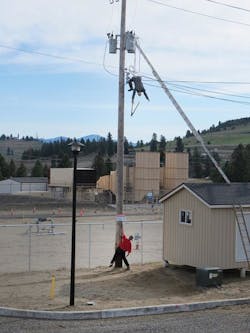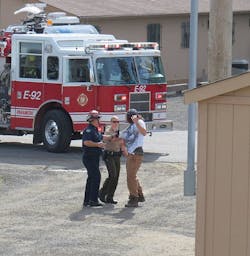When a lineman is seriously injured or killed on the job, electric utilities often send accident investigators to the scene. These field professionals are tasked with understanding the root causes of the accident and then helping to prevent similar accidents from happening in the future.
Experiencing the pain and suffering of the field crew and families up close, however, can be a heart-wrenching experience. As such, accident investigators may spend many sleepless nights tossing and turning while thinking about all the serious accidents they have observed.
Accidents and fatalities also have a profound effect on the field workforce, and following an incident, they often spend time in shock and mourning. After that time, linemen often make significant improvements in their safety practices. This increased focus on safety, however, isn’t confined to just the field. Instead, employees throughout an electric utility often take a new perspective and begin to consider their own safety circumstances. Following a tragic accident, they start thinking about likely scenarios, potential outcomes and existing limitations. As a result, they begin to see problems even before they happen.
Avista Utilities realized that the tragedy and pain of an accident was the most powerful tool in its safety arsenal. While the electric utility industry has experienced a major shift in the attitude about safety, accidents still happen. Many utilities have enacted policies, developed procedures, created training programs and invented safety equipment, but Avista took a more unique approach to safety by recreating serious accidents.
Setting Up the Mock Incident
Mock incidents enable Avista Utilities to help its employees contemplate the possible implications and safety issues without the emotional pain or financial costs of an accident. The utility first staged the mock accidents at the Colville and Pullman Training Centers. Employees posed as both the victims and the personnel rendering aid, and MedStar Air Ambulance Service and the local fire and police departments provided additional support.
Three years after its first mock accident, Avista staged another incident, but this time, it focused on copper theft and occurred at the Jack Stewart Training Center. Like the first two mock incidents, this one was also done with the element of surprise and only a limited number of employees were aware that it was happening.
The majority of the mock incidents also took place in very remote locations or in the inner city so that Avista could test its system to the fullest extent. In addition, they all required a significant amount of preplanning. Avista had to coordinate with many participants internally and externally, and support groups observed, monitored and compiled the information used to assess and determine the needed adjustment to applicable internal emergency protocols.
This scenario involved three individuals attempting to remove copper from Avista’s energized electric system. The mock incident was staged on an Avista pole that had a bank of three transformers mounted on it, with a three-phase service extending from it.
The three individuals who posed as the thieves were trying to remove copper from the service. To reach the copper, the first individual extended a ladder to the roof of a building next to a pole. From there, he placed a ladder on the roof top and then extended it to a point event with the “C” phase transformer primary jumper. After leaning the ladder against the pole, he then climbed the ladder while the second individual began to remove the copper ground at the base of the pole.
Reaching the point of energized primary, the ladder then shifted, making contact with the energized primary jumper. Both individuals were electrocuted. The first individual fell onto the three-phase service lines, where he remained folded over the service line. The second individual was caught in the copper ground wire at the base of the pole. The third individual was not injured, but he remained on site.
Responding to the Emergency
After staging the first part of the incident, Avista waited for the response. After a passerby noticed the problem, he called the Avista call center to report that two bodies were on the power line. At the request of the call center representative, the passerby stated he would also call 911 to report the problem.
The call center representative then generated and provided a trouble order to the 24-hour representative, the passerby called the 911 operator, and the 911 operator shifted the call to the Fire District 9 dispatcher, who dispatched EMS and fire department personnel.
Fire district first responders, along with the sheriff department, arrived on the scene and stood by awaiting arrival of the Avista.
Meanwhile, the third individual involved in the copper-removal process explained what he and the other two individuals were doing when the accident occurred. He was then arrested and taken into custody, and later on, the sheriff department determined that he was part of the copper theft ring.
Avista dispatched a serviceman to the scene, and 10 minutes later, dispatched a line crew. They arrived on the scene to assess the situation and make the scene electrically safe so the victims could be removed and treated. The crew members opened the cutouts to de-energize the primary high-voltage source to the transformers where the initial contact was made with the ladder. In turn, they de-energized the secondary low-voltage source from the transformers, making it safe to remove both victims from the system.
The individual who tried to remove the pole ground was removed from the system. Avista linemen then began treatment as EMS deemed the situation safe. They then moved toward the site to assist and take over the treatment of the victim. Later, they removed the first individual from the line and lowered him down to the ground, where EMS began treatment. EMS worked on this individual for 12 minutes, but was unsuccessful in reviving him. EMS, however, was able to stabilize the second individual and load him into an ambulance for transport to the hospital, thereby officially concluding the mock accident.
Looking to the Future
Following the mock accident, Avista evaluated the response from the field workforce, call center team, and local fire, police and EMS teams. The departments were then responsible for making the necessary emergency protocol adjustments.
The utility also reviewed, discussed and determined how real-life scenarios can be incorporated into the annual pole-top and bucket rescue practices that linemen engage in.
By offering real-world training scenarios, Avista linemen now feel more comfortable responding to an actual emergency. While it is one thing for the crews to practice their response skills in a low-stress environment, it became much more effective for the linemen to work with local emergency responders in a time-sensitive situation.
Through the mock accidents, the utility was able to pinpoint issues of concern, come up with possible solutions and is prepared to handle future emergencies in the field.
Mike Toutloff ([email protected]) is a lineman and foreman for Avista Utilities. He has worked in the industry for 25 years and has chaired the dock safety committee for eight years. He has also served as an accident investigator. Since 2010, he has also helped to recreate mock accidents at Avista Utilities as a way to train linemen on safety practices.
Editor’s note: Visit http://tdworld.com/electric-utility-operations/avistas-simulated-copper-theft-incident-trains-crews-emergency-response to see a gallery of images from the scene of the mock accident. Also, visit https://www.youtube.com/watch?v=hu8gbe4suAE to see a video from a mock accident.
Sidebar: Mock Emergency Timeline
- 8:30 a.m.: Compton 12F2 locked open and a report is made to the Avista call center that two victims were on the power line following a flash and loud noise.
- 8:32: The call center notifies the 24-hour representative, and the customer calls 911.
- 8:33: An Avista serviceman is notified of the incident and is in route to Compton substation.
- 8:41: The general foreman is notified of the incident.
- 8:42: Fire District 9 and 18 are dispatched to the scene.
- 8:43: Distribution dispatch sends the foreman and his crew.
- 8:45: Fire District 9 arrives on the scene and stands by, and the sheriff arrives on the scene.
- 8:47: The third individual involved with the copper theft is arrested after informing the fire department about what has happened.
- 8:48: Fire District 18 arrives and stands by.
- 8:52: The ambulance arrives.
- 8:57: The Avista servicemen and crewmen arrive on the scene, and distribution dispatch notifies the Avista safety department.
- 8:59: The Avista claims department is notified.
- 9:00: The system is de-energized, and the fire department is given the permission to engage.
- 9:02: The second victim is removed by the Avista crew. They then work with the fire department to treat the victim.
- 9:04: Distribution dispatch notifies the Avista corporate communications department.
- 9:13: Avista personnel and the public are in the clear, and Compton 12F2 is re-energized.
Sidebar: On-Scene Arrival Times
- EMT: 15 minutes
- Fire: 15 minutes
- Sheriff: 15 minutes
- Ambulance: 22 minutes
- Avista: 27 minutes
- System de-energized: 30 minutes
- Treatment began on victim #2: 33 minutes
- Treatment began on victim #1: 34 minutes
- Victim #1 fatal/Victim #2 transported: 42 minutes
- Avista system returned to normal: 43 minutes
Sidebar: Lessons Learned
Following the mock accident at the Jack Stewart Training Center, all of the departments reviewed their response to the incident and then identified necessary adjustments to their plan of action. Here are some of the changes that each department plans to make to its emergency protocols.
Call Center: The utility found that the call center representative effectively followed internal protocol, however, the call center should have contacted 911 to ensure that the notification was made. Otherwise, there could have been a delay in EMS response.
Distribution Dispatch: To help the department respond to a future mock or actual emergency or electrical contact, Avista will develop a one-page, laminated flip-chart card to direct the dispatcher to call claims, corporate communications, safety and health, the operations manager, and the chief distribution dispatcher. Such a process card would then direct the dispatcher to go to the callout/notification list in the utility’s call-out system.
Field Workforce: One issue that Avista identified was that of problems with the linemen’s radios during the mock incident. Because there was no external speaker on the old system, the crews working outside of their vehicle could not hear the radio. Also, the temporary sled-mount radios often didn’t work, or the placement of the radios was inconvenient for the operators. As such, they couldn’t easily access the radio or tell if it was on or off. At times, they couldn’t hear the speaker even if they were inside the vehicles, and, at that point, the new system was not yet operational in Spokane, Washington. As a result, the field workforce used cell phones to communicate during the mock incident.
Safety Department: Avista has established a protocol that the safety manager, director or senior director must inform the vice president, initiate necessary processes and maintain incident oversight. They also need to notify other safety specialists and additional personnel on an as-needed basis. And in the future, safety department personnel may be staged in departments to observe and collect information that will determine needed departmental protocol adjustment.
Claims Department: The claims department didn’t recognize the 800 number from dispatch, and as a result, didn’t answer the initial call. Now all calls from that department will appear as either BLOCKED or as a certain four-digit number on the cell phones.






